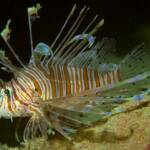


SCORPIONFISH
Pterois andover:
This new species of scorpionfish is from primarily the Western Pacific, Indonesia and Papua New Guinea. They are also found in the East Indian region, Sabah, and the Philippines. They inhabit on or near turbid inshore reefs surrounded by soft sand-mud bottoms, often in the proximity of freshwater discharge.
They have 13 total dorsal spines with 11 dorsal soft rays. They have 3 anal spines with 7 anal soft rays, and 12-14 total pectoral rays. They have vertical scale rows in a longitudinal scale series 62-72, and horizontal scale rows above lateral line 9-10 and below lateral line 13-15. Their dorsal spines are narrow inconspicuous membranes on the posterior edge with exaggerated pennant-like flap distally. They have relatively few dark spots on median fins, 5-28 on dorsal fin, 10-19 on anal fin, and 17-41 on caudal fin. Their first dorsal spine is relatively short.
PTEROIS ANDOVER
WANTED
Lionfish
Dead or Sautéed in Butter!
Website Designed by Tami Beckel for Vone Research, Inc. © 2010. Vone Research is a 501(c)3, non profit organization.
Please report broken links to the Webmaster

This new species superficially resembles Pterois volitans (red lionfish), a sympatric widespread Pacific species, but differs in having larger body scales (81 and 18-25 respectively) and usually 13 versus 14 pectoral-fin rays. The two species are readily distinguished underwater on the basis of dorsal fin morphology, particularly the shape and color of the spine membranes. Pterois andover possesses a narrow membrane posteriorly on each spine, which is more or less uniform brown and terminates in an exaggerated pennant-like structure. In contrast, the membranes of P. volitans are broader, boldly striped, and usually lack a well differentiated terminal pennant. The new species also has consistently fewer and fainter spots on the caudal, soft-dorsal, and soft-anal fins except for the population of P. volitans from western Australia.
